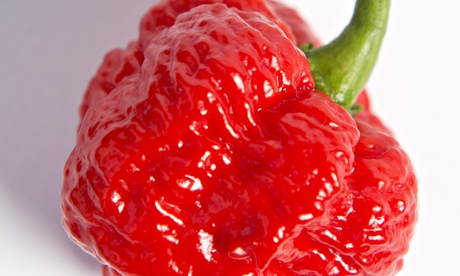
Here’s the plan: I’m going to give you a backpack filled with plastic bags – some will be filled with fresh mint leaves and others with juicy habanero chilli peppers. You’ll also get a clipboard, a pencil, a spare pair of socks and a round-the-world aeroplane ticket. Your job, should you choose to accept it, is to travel the world and visit all sorts of places, from the biggest cities to the most remote jungle encampments. In each location you will seek out a wide variety of people – young and old, rich and poor – and then rub chopped-up mint leaves or diced chilli peppers on their skin, then ask them to describe the sensation and record their responses. Try applying the samples on both the glabrous skin of the lips and the hairy skin of the forearm. (These substances don’t have to touch the tongue for their effects to be experienced.)
If you conducted this survey where I live, in Baltimore, you would find that the dominant word used to describe the tactile experience of the habanero, smeared on either the lips or the forearm, would be hot, while for mint it would be cool. Is this merely a convenient turn of phrase, a colloquialism? After all, if we were to use a thermometer to measure the actual temperature of mint or chilli, we would find that they are not literally hot or cool. And of course in other contexts these are words used metaphorically – to mean, for example, stylish (“the Tesla Roadster looks so cool”) or sexually attractive (“Rachel Weisz is so hot”).
Are “hot chilli peppers” or “cool mint” a different kind of local, culturally constructed response, or do they reflect some deeper biological reality? If they are merely cultural constructions, you would expect to find groups of people in your world-travelling survey who don’t describe them in the same way.
To my knowledge, this particular ethnographic survey has yet to be done, but from a biological perspective we can predict how it would turn out. Given what we know about the biology of touch, we would predict that nearly every person around the world would describe chilli as hot and mint as cool, even if he or she were experiencing these tactile sensations for the first time and had never heard others describe them. It appears that the cool mint and hot chilli metaphors are biologically hard-wired.
The main active ingredient in mint is menthol, while its equivalent in chilli is a chemical called capsaicin. Less potent chillis, such as Anaheim chillis, have a low concentration of capsaicin, while very strong ones, like the Bhut Jolokia pepper, can produce about one-thousand-fold more. So why are we biologically predisposed to perceive menthol as cool and capsaicin as hot? One possibility is that there’s a class of nerve ending in the skin that can sense cooling and a different class that can respond to menthol. The signals conveyed by these distinct fibres could then ultimately converge in the brain: mint and cooling might feel the same because they activate the same brain region dedicated to the sensation of cooling. In an analogous fashion, separate heat-sensing and capsaicin-sensing nerve fibres could ultimately send their impulses to a heat-sensitive brain region.
This hypothesis rests on signal convergence in the regions of the brain that process touch information, and while it’s reasonable and appealing, it’s actually dead wrong. How do we know that? First, we can record electrical signals from single sensory nerve fibres in the arm that respond to both heat and capsaicin, and other single nerve fibres that respond to both menthol and cooling. These show that temperature and chemical signals are present in the neurons that innervate the skin long before any signals reach the brain. We also have some molecular evidence. There are free nerve endings in the outermost layer of the skin that contain a sensor on their outer membrane called TRPV1. This single protein molecule can respond to both heat and capsaicin by opening an ion channel, a pore that lets positive ions flow inside, thereby causing the sensory neuron to fire electrical spikes, the primary mode of long-distance communication in nerves and brain. Similarly, there are free nerve endings in the skin that contain a different sensor, called TRPM8, and these can respond to both menthol and cooling.
How did thermosensitive proteins such as TRPV1 and TRPM8 become sensitive to plant products like menthol and capsaicin? We can’t know for certain the sequence of evolutionary events that gave rise to these two dual-function sensors. The best guess is that TRPV1 and TRPM8 evolved in some animals as temperature sensors, and that certain plants later developed compounds that would activate them in order to deter their consumption by animals. Plants that produced menthol and capsaicin would therefore have a survival and reproductive advantage and become more prevalent in the population of that species. In this scenario it’s plant evolution that initially drove the dual-function properties of the thermosensors, not animal evolution.
The answer to our puzzle is that the metaphor of hot chillis and cool mint is not in the culture, or even in the brain region. In fact, the metaphor doesn’t originate in the brain at all. It is encoded within the sensor molecules in the nerve endings of the skin and probably emerged through evolutionary interplay between plants and animals.
• Touch: The Science of Hand, Heart and Mind by David J Linden is published by Viking on 5 March.

